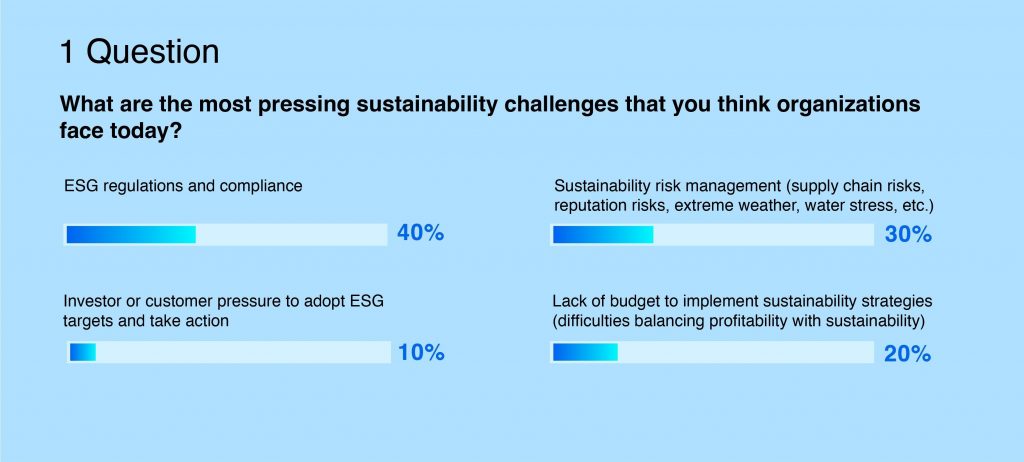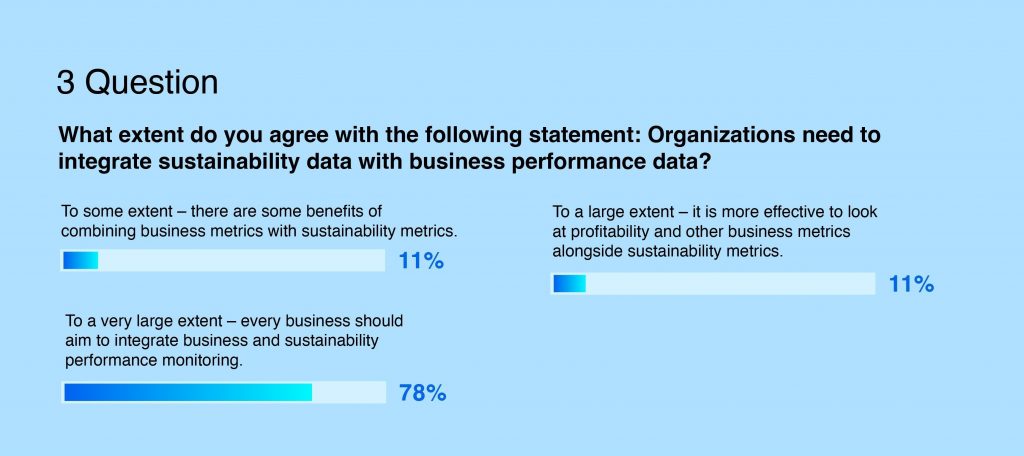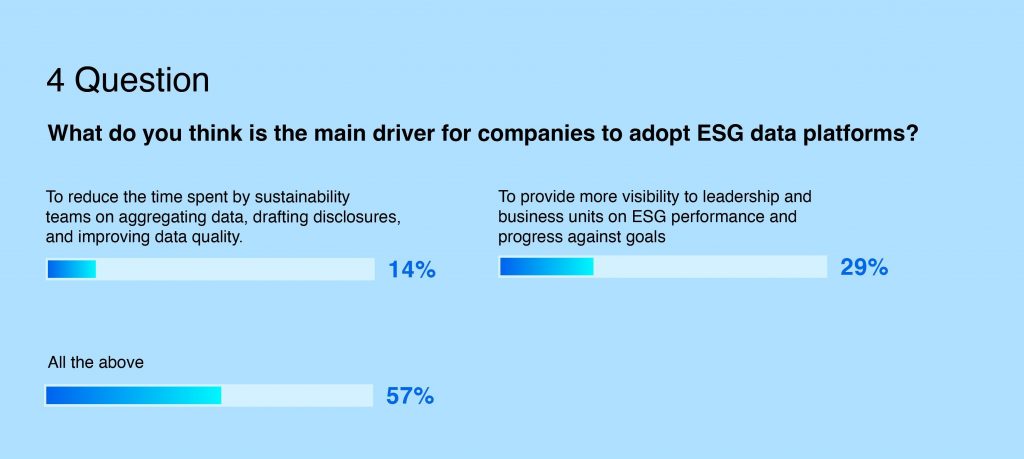After a successful webinar on digital transformation and sustainability, we organized a sequel titled “Data-Driven Sustainability Journeys from ESG Data to Business Value.”
We invited Rik Irons-Mclean from Microsoft and Aditya Bhardwaj our client partner for ESG Tech & Analytics. Shravan Kumar, our senior director at Client Success, moderated the session, focusing on the challenges of ESG data, enhancing organizational performance through sustainability, and transforming ESG data into actionable insights.
In this article, we’ll highlight the key takeaways from the webinar.
Table of Contents
Microsoft’s Net Zero Goal and Responsible AI
Shravan elaborated on Microsoft’s sustainability goals, noting that the company aims to be carbon-negative by 2030. By 2050, it plans to eliminate all its historical carbon emissions dating back to its founding in 1975.
The discussion also covered the importance of responsible AI, emphasizing the need for transparency, reducing bias, safeguarding privacy, and ensuring inclusivity in AI development, aligning with ESG principles. Additionally, it was noted that organizations approach sustainability in various ways, with some focusing primarily on compliance with government regulations as a short-term strategy.
We launched a poll to understand the key sustainability challenges our audience is facing.
Most of them shared ESG regulations and compliance as pressing challenges. A few nominated supply chain risks, pressure in adoption, and a lack of budget as their major challenges.
Challenges to Sustainability
Rik highlighted that 70% of surveyed companies view sustainability as a revenue enabler, not just a cost center, with these companies experiencing nearly 16% higher revenue growth.
This emphasizes the importance of sustainability in business success.
The discussion then shifted to the primary sustainability challenges organizations face, such as regulatory compliance, risk management, investor or customer pressures, and budget constraints.
These challenges underline the need for business models that value sustainable transformation and address skill shortages in the workforce.
Rik advocated for expanding accountability beyond the ESG teams to include all stakeholders, ensuring a cultural shift towards shared responsibility in sustainability efforts. This approach also leads to operational efficiencies and opportunities for new business growth and competitiveness.
Importance and Implications of ESG Data Management
Companies are expected to collect ESG data now beyond their operations, encompassing their entire value chain. This involves addressing various factors like carbon emissions and social risks while adhering to evolving regulations.
However, many companies face challenges in collating this data, emphasizing the importance of viewing it as a gradual journey rather than expecting immediate results.
Companies can ensure comprehensive and efficient reporting by progressively enhancing administrative systems and leveraging the right resources. Sustainability, like exercise, requires consistent effort over time for meaningful impact.
When asked about the crucial challenges organizations face in managing ESG data, our audience nominated the quality of ESG data and difficulty generating insights as crucial challenges.
Advantages of Data Migration to Microsoft Sustainability Manager
Data management complexity is underscored by the need for high-quality, auditable data across business facets, which is essential for informed decision-making and sustainability reduction.
Moving beyond viewing data solely for reporting, standardized approaches like Sustainability Manager streamline the collection, automating ingestion for reliable insights.
This quality data helps identify outliers and supports governance practices, freeing up time for impactful activities. Such platforms enable swift, reliable reporting and informed decision-making, enhancing focus on sustainability goals.
Align your ESG performance with your Business Performance
Effective integration of sustainability within an organization hinges on committed leadership and cross-functional collaboration.
Leadership drives the integration process, while collaboration across departments ensures alignment with sustainability goals. Examples include integrating ESG criteria into procurement processes and embedding sustainability metrics into key performance areas of leadership.
Overall, sustainability must permeate the organization’s strategy, decision-making, and governance framework.
Collectively our audience agreed that every business should aim to integrate business and substantiality performance monitoring. Integrating business and sustainability performance monitoring is vital for holistic success.
It ensures alignment between organizational goals and environmental, social, and governance objectives. By tracking both aspects, companies can identify synergies, mitigate risks, and capitalize on opportunities, fostering long-term resilience and creating value for stakeholders while advancing sustainability agendas.
Importance of ESG Reporting
Organizations must prioritize developing a comprehensive sustainability strategy, aligning it with their goals, and adapting to change.
Regular reviews ensure ongoing activities remain consistent with commitments and facilitate progress toward future objectives, maintaining credibility and reputation. Beyond regulatory compliance, aligning investment decisions with sustainability goals, including supplier performance, significantly impacts reports and overall performance.
Real-time adjustments through regular reviews enhance organizational resilience, addressing potential negative impacts and supporting comprehensive risk management, potentially influencing financial performance and competitive advantage.
How can Sustainability Data Drive Business?
Sustainability requires businesses to evolve while maintaining productivity. ESG data is a strategic tool for organizational transformation, driving action in tracking progress, improving sustainable practices, enhancing transparency, and even shaping new business models.
Data analysis informs actions, such as monitoring environmental metrics at product levels and analyzing turnover and profitability. Integrating sustainability data with business data enables informed decision-making across functions, maximizing value and linking business performance with ESG performance.
Exploring Companies’ Motivations for ESG Technology Investments
Data and digital technologies are fundamental to sustainability initiatives, and research entities like the United Nations and the World Economic Forum support them.
These technologies enhance reporting processes, such as Microsoft Sustainability Manager, by automating and generating insights. IoT contributes to operational efficiencies through sensor-based monitoring, while cloud-based technologies foster collaboration and innovation.
Blockchain and AI, including generative AI and scenario modeling, further streamline processes and enhance transparency. However, technology must align with operational workflows, and industry context influences priorities. Ultimately, when employed effectively, data and digital technologies enable sustainable change.
In one poll, the majority revealed that reducing the time spent by the sustainability team and providing more visibility are the main drivers for companies to adopt ESG data platforms.
Key Considerations for Investing in Data and AI Solutions for ESG
Successful adoption of data and digital technologies for ESG involves more than just implementation.
It requires strategic organizational utilization.
Key considerations include gaining buy-in from stakeholders, fostering a supportive culture, and ensuring the right skill sets are in place.
Establishing a solid data foundation is crucial, along with considerations for openness, standardization, and extensibility in ESG solutions to adapt to regulatory changes and technological advancements.
Lastly, deploying these solutions is an ongoing journey requiring processes for growth and adaptation as the organization evolves.
Aditya further shared that effectively managing ESG data requires balancing people, processes, and technology. Technology, such as cloud solutions and AI, optimizes sustainability teams’ time by streamlining data processing and automating insights generation.
While investing in data solutions brings benefits, flexibility is crucial to adapt to evolving ESG regulations. Seamless data integration from multiple sources is essential for efficiency, and addressing diverse user needs ensures maximum value from data investment.
Start your ESG Journey with Gramener
Gramener empowers businesses’ sustainability journeys by leveraging ESG data to drive tangible business value. Through advanced analytics and visualization, Gramener transforms complex data into actionable insights, enabling informed decision-making. By integrating ESG metrics with business strategies, Gramener facilitates sustainable growth, risk mitigation, and competitive advantage.






